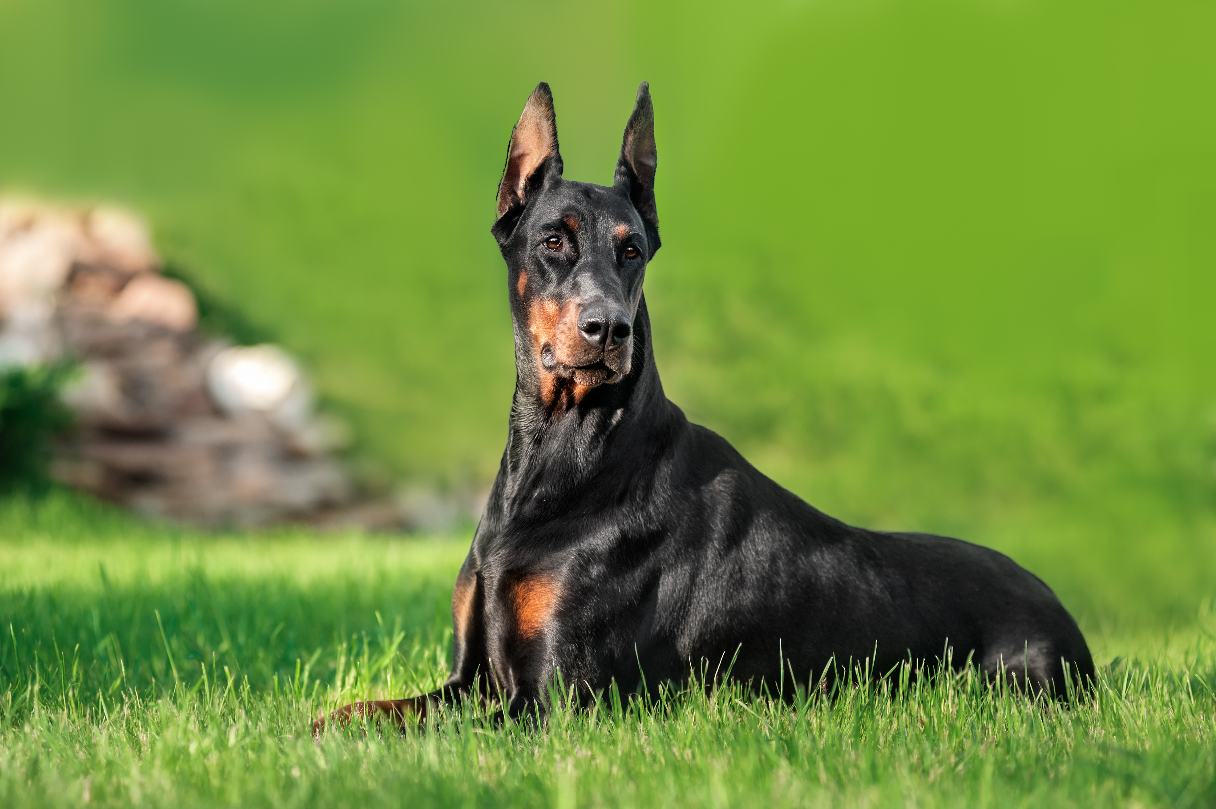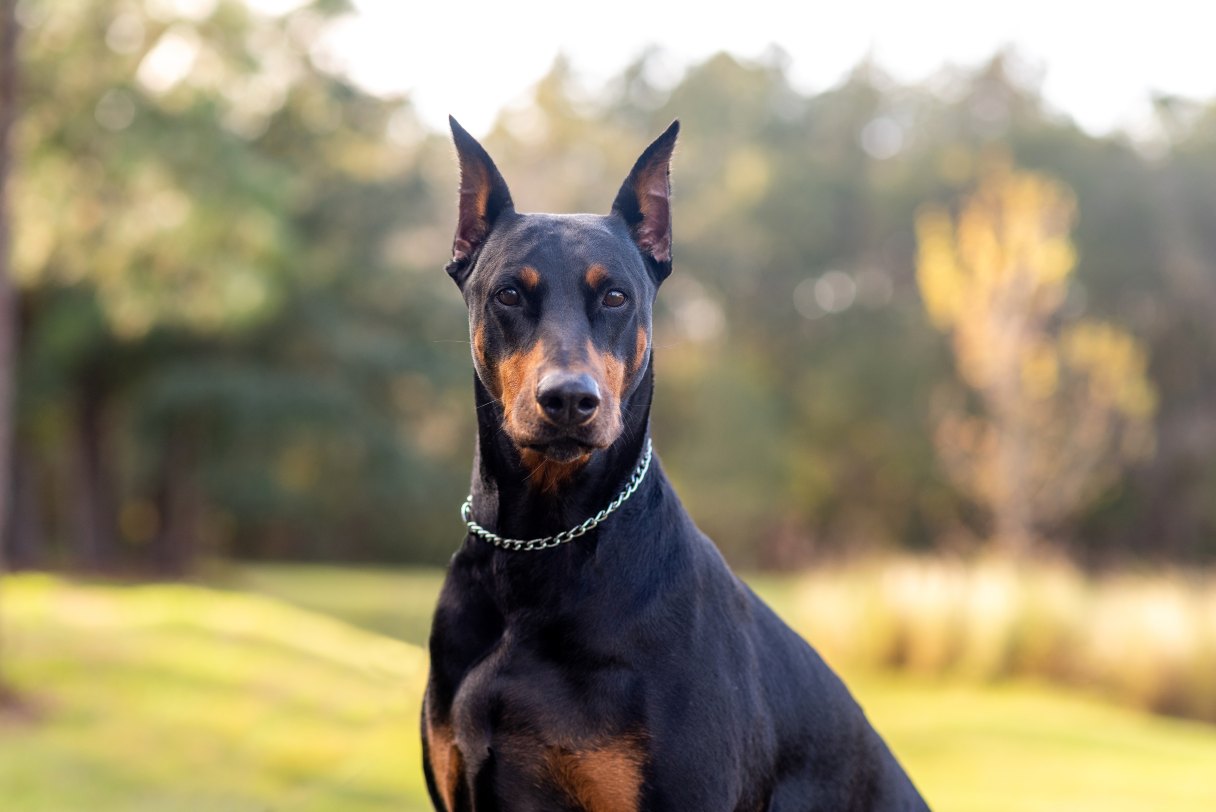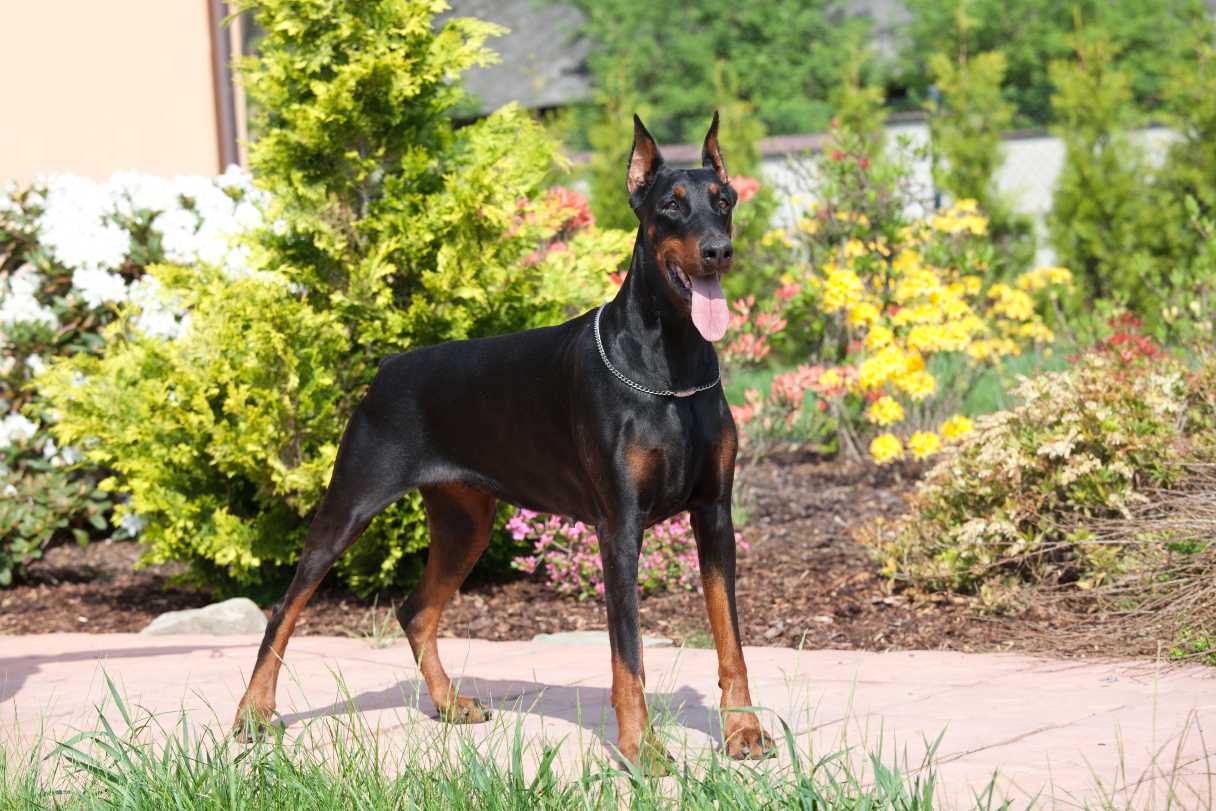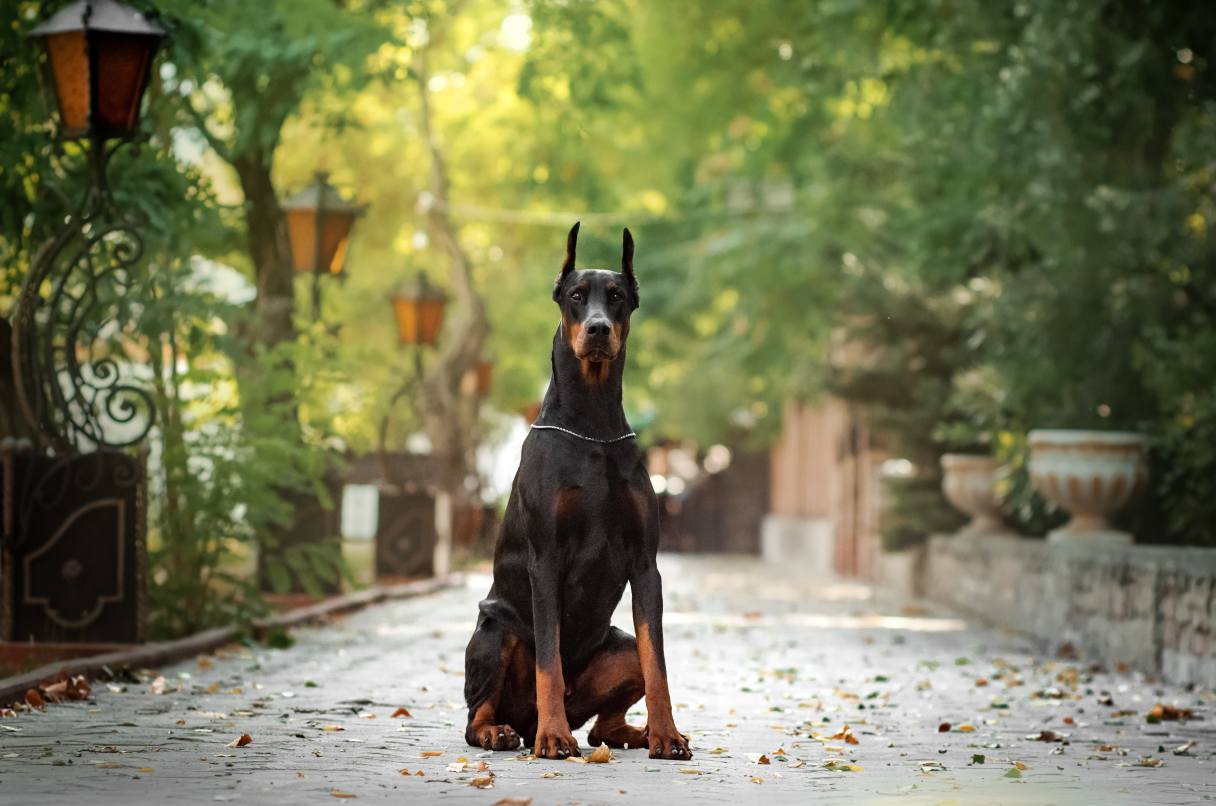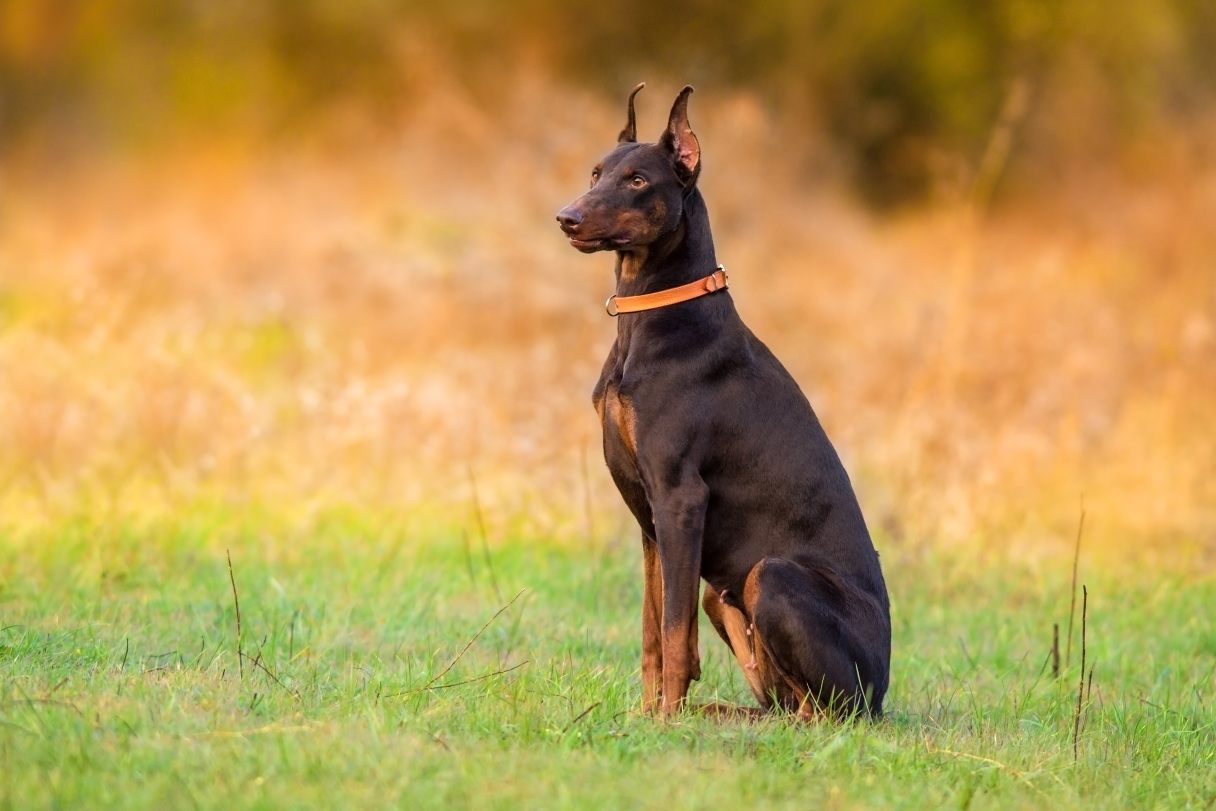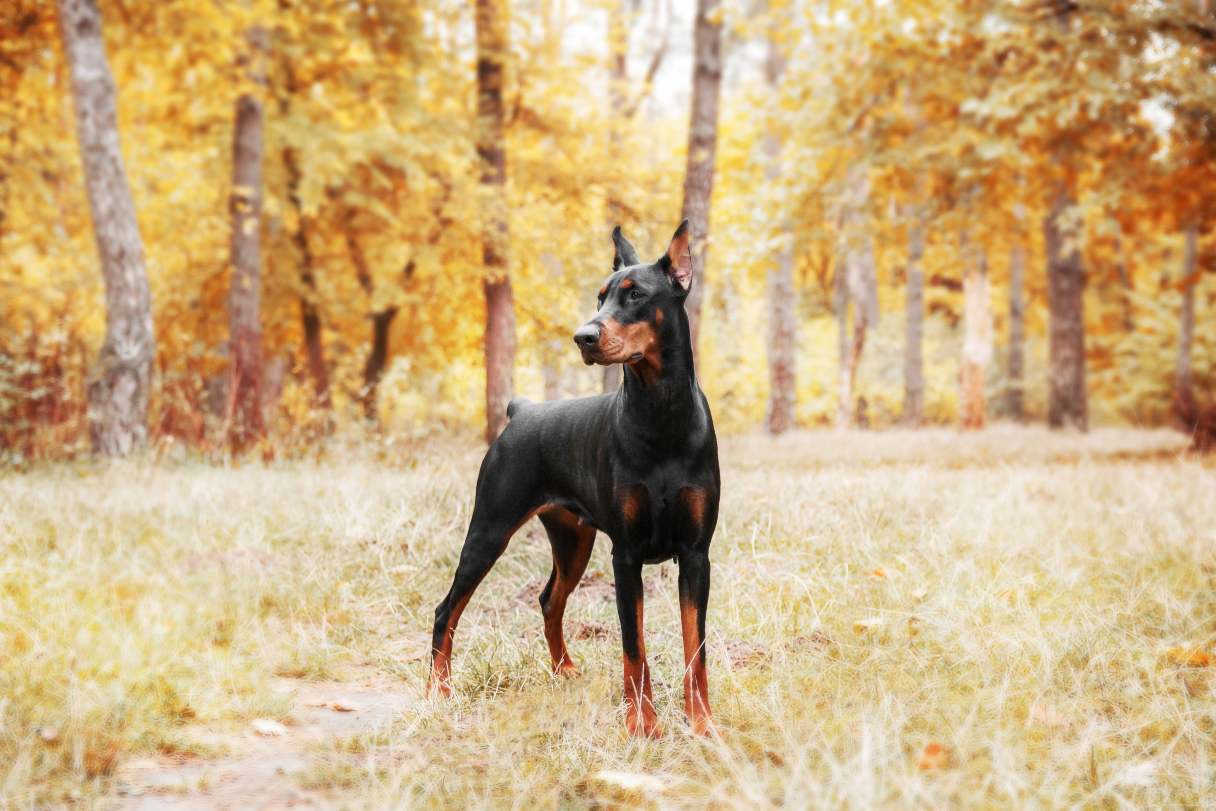The Doberman pinscher is an elegant-looking dog with many excellent qualities that have garnered this breed a noble reputation in the world of dogs. Highly intelligent, intensely loyal and fearlessly protective, well-trained Dobes are also loving and obedient.1
Learn more about the Doberman pinscher, including its temperament, training, health and maintenance needs and what it’s like to live with these versatile working dogs.
About Doberman Pinschers
A 19th-century German tax collector named Louis Dobermann — whose numerous side hustles also included dog breeding — wanted to develop a fearsome but dependable protection dog to accompany him when he made collection calls to potentially hostile tax debtors. This resulted in a larger, rougher version of the modern-day Dobe.1
No one is sure exactly which breeds Dobermann used to develop his faithful guardian (named after its breeder minus the second n), but educated guesses include the German shepherd dog, rottweiler, German pinscher and the Weimaraner. Later, the Manchester terrier and the greyhound were added to the mix to give the Dobe the sleek and refined appearance that we know today.2
With such a well-rounded gene pool, the Doberman quickly proved itself to be more than just an excellent guard dog. These intelligent and versatile working dogs also excel as police and military dogs, service and therapy dogs and search and rescue dogs.1 The Dobe was also named the official war dog of the United States Marine Corps during World War II.2
How or when the Doberman pinscher came to North America is unclear, but they were added to the American Kennel Club’s (AKC) registry in 1908. Since then, they’ve consistently remained one of the most popular working dog breeds in the United States.1
Doberman Pinscher Appearance

Dobermans are large dogs, with males standing 26 to 28 inches at the shoulder and weighing 75 to 100 pounds.1 Females are a bit smaller, reaching 24 to 26 inches and weighing in at 60 to 90 pounds.1 Their appearance is sleek, muscular, elegant and proud, built for speed and endurance.3
The head is shaped like a wedge when viewed from both the front and the side, with a long, tapered muzzle and an expression that’s intelligent and alert.3 The breed standard calls for ears to be cropped into erect triangles and the tail to be docked at the second joint.3 However, the American Veterinary Medical Association discourages ear cropping and tail docking for merely cosmetic purposes.4 When left natural, the ears are rounded on the ends and hang down to the jawline, and the tail is long, narrow and tapered, held high and curving up over the rump.3
The Doberman’s coat is short and smooth, and there may be a slight undercoat around the neck. Their primary coloring may be black, blue, red or fawn, all with distinctive rust-colored markings on the face, chest and legs.3
Doberman Pinscher Temperament
The ideal Doberman pinscher temperament is described as “energetic, watchful, determined, alert, fearless, loyal and obedient.”5 With good breeding, proper training and lots of socialization, Dobes are affectionate and well-mannered guardians of home and family, open to strangers, great with children and able to mix well with other pets.1 However, without those things, Dobes can be highly problematic — willful, destructive and even dangerous toward strangers, other dogs or any perceived threats to their people.1
Dobes are keenly intelligent and quick learners, and with training, they learn to be extremely obedient.1 They do have a willful streak that can make training a challenge, however.1 Early socialization and obedience classes are recommended to start Doberman puppies out on the right track.1 Once they learn what’s expected, they tend to be fiercely loyal and obedient.5
The Doberman’s devotion to their humans is unmatched. They need to be with their people, both for companionship and to keep them safe.5 As effective as they are at guarding property, they’re not meant to be left outside, but to live indoors with their people.1
Their high companionship needs can make them prone to separation anxiety, but crate training and conditioning them to be on their own from a young age can help curtail this. Providing plenty of exercise and mental stimulation will also help them cope with being left alone.6
While a Doberman pinscher parent must be diligent in providing consistent training and socialization to prevent inappropriate aggression and other problematic behaviors, good breeding is imperative when it comes to a desirable temperament. When looking for a Doberman, it’s essential to research breeders to find one who is ethical and responsible and whose puppies come from stable and proven bloodlines.7
Living With a Doberman Pinscher
Dobermans are excellent dogs in the right hands, but they can be challenging for some people to handle. Their size and potential for aggression make them a significant responsibility. Here’s what you should know if you’re considering bringing a Dobe into your life.
Who they’re best for
A Dobe needs an experienced and active handler who can commit to their substantial training, socialization and exercise needs and who understands that they can be a real handful, especially during the first two years.7 They need someone who is responsible and disciplined enough to be consistent with training, the lack of which could lead to trouble and even a great deal of harm.8 Dobermans also need someone who can deal patiently with their constant watchdog vigilance and desire to investigate everything.8
A well-bred and well-trained Dobe can be a wonderful addition to a family with children and other pets. However, they can be prone to aggressive behavior toward other dogs, especially those of the same sex.9 But Dobes tend to get along well with dogs they’re raised with from puppyhood.
Their high prey drive can make Dobermans potentially dangerous to small dogs and cats. Extensive socialization with other dogs, cats and small pets from a young age can help them learn to accept other animals into the household. However, due to their size, exuberance and potential for aggression, they should never be left alone and unsupervised with small children or small pets.
Living space
Dobermans can adapt well to the town or country, but they need a yard with a tall and sturdy fence where they can safely burn off some of their energy. They love to run at full speed and may dash into traffic without a clear boundary to contain them. Additionally, they don’t always have reliable recall — that is, coming to you when you call them — when they’re in motion.5
Exercise and activity
These dogs are extremely energetic and athletic.1 They need an active owner who will enjoy taking them hiking or on long walks or runs or who can participate with them in canine sports.1 They can get bored easily without enough stimulation; puppies especially can get themselves into trouble without healthy outlets for their curiosity and their love of investigation.5
Dobermans enjoy going wherever their families go, and they tend to make great travel companions for long road trips.10 Their separation anxiety tendencies could make long hours of air travel a challenge for them, however. Getting them accustomed to traveling in a crate from a young age can help, as can gently getting them used to being alone when you leave.6
Grooming
The Dobe’s short coat is generally low-maintenance. A daily once-over with a brush or grooming mitt will keep their coat clean and shiny, and baths are only required for big messes. Their ears should be cleaned regularly to avoid any ear health issues, and monthly nail trimmings and regular toothbrushing will help keep them in tip-top shape.1
Doberman Pinscher Health and Life Expectancy

On average, Doberman pinschers live 10 to 12 years.1 However, genetics, lifestyle, nutrition and healthcare are all factors that help determine an individual dog’s lifespan. Providing a nutritious diet, maintaining a healthy weight and scheduling regular vet checkups can go a long way in helping your Dobe live a long and happy life.
Your Dobe will thrive on high-quality dog food that matches their life stage and meets nutritional standards developed by the Association of American Feed Control Officials.1 Dog and puppy food that’s formulated for large breeds will support their large and rapidly growing bones.11 If you’re unsure about the best type or amount of food for your dog, consult your vet for guidance.
While Dobes are generally healthy dogs, they are prone to certain health issues despite the best efforts of ethical breeders to test and screen their dogs for genetic health conditions. Some of them can be serious and quite costly to treat or manage.
Here are some health issues that are common to Doberman pinschers:
Bloat
Gastric dilatation and volvulus (GDV), also known as bloat, is a potentially fatal condition in which gas causes the stomach to bloat and twist on itself, cutting off circulation. All large, deep-chested dogs are prone to this condition, signs of which include a bloated abdomen and dry heaving. Feeding smaller meals throughout the day and avoiding exercise around meal times can reduce the likelihood. You can consult your vet about a simple surgical procedure that can prevent bloat from occurring.12
Cancer
While Dobermans are not genetically predisposed to cancer, some research has found higher incidences in the breed compared to others.13 Unfortunately, no dog is exempt from the possibility of developing cancer. You should discuss the likelihood of cancer with your vet, especially when making decisions about spaying or neutering. Report any unusual lumps or bumps, changes in health or shifts in behavior to your vet, and schedule regular checkups to aid in early cancer screening and detection.
Dilated cardiomyopathy
This heart condition causes the wall of the left ventricle to progressively thin, weakening the heart muscle and forcing it to work harder to pump blood throughout the body. Dilated cardiomyopathy is the most common cause of congestive heart failure in Doberman pinschers and may be managed with a combination of medications, a specialized diet and lifestyle changes.14
Hip dysplasia
This genetic abnormality of the hip joint prevents the ball from fitting properly into the socket. Hip dysplasia can be painful on its own and also causes joint wear and tear, eventually leading to arthritis and mobility issues. Severe cases may require surgical intervention.15
Hypothyroidism
This condition occurs when the thyroid gland doesn’t produce enough hormone to properly regulate metabolism, leading to a slow, sluggish metabolic rate and a host of related health issues. Common signs include fatigue, a dull or patchy coat and unexplained weight gain. Fortunately, it’s easily managed with thyroid replacement medication.16
Progressive retinal atrophy (PRA)
PRA is a condition in which the photoreceptor cells in the eye’s retina deteriorate over time, causing poor vision and, eventually, total blindness. This can affect puppies or older dogs, and there is no cure. However, both puppies and grown dogs can adapt well to a sightless life with the help of a few accommodations.17
Von Willebrand disease
The Doberman pinscher has a higher incidence of this disorder than any other breed. Von Willebrand disease is a blood disorder where platelets lack sufficient amounts of a clotting protein called von Willebrand factor, potentially leading to spontaneous hemorrhaging or prolonged bleeding. In severe cases, dogs may be in danger of bleeding to death. However, many dogs show no symptoms and can lead healthy, happy lives. It's important for your vet to be aware of this condition when prescribing medications or considering surgery, so you may consider having your dog screened for this disorder.18
Wobbler syndrome
This condition, commonly referred to by its wobbly walk, is caused by spinal compression, leading to a lack of coordination or stiffness in the limbs. Treatment may involve a combination of corticosteroids and rest, but more advanced cases often require surgery and extensive physical therapy.19
Buying or Adopting a Doberman Pinscher
Good breeding is always important, but it’s vital when it comes to finding a Doberman with the right temperament. You can find ethical breeders through the AKC marketplace website, offering Doberman pinscher puppies from championship bloodlines, typically priced between $2,500 and $4,500 and up.20
Doberman pinschers and Dobe mixes of all ages may be available for adoption through pet shelters and dedicated Doberman rescue organizations. It’s important to research any rescues you're considering to ensure they are educated about Dobermans, understand the breed's specific needs and thoroughly screen and socialize their dogs before adoption.7 Adoption fees at shelters and rescues vary by location, but the Doberman Rescue League, Inc. typically requests a donation of $300 and up, depending on the dog's age and individual circumstances.21
You can also find a nationwide list of Doberman rescue organizations on the Doberman Pinscher Club of America website.
Frequently Asked Questions About Doberman Pinschers
Do you still have questions about Doberman pinschers? Here are some answers to commonly asked questions about this dog breed.
CareCredit Credit Card Financing for Dogs
Taking good care of your pet's well-being from nose to tail is essential. Make sure to stay up to date on their regular checkups at the vet to help keep your pet happy and healthy for a lifetime of love. You can use your CareCredit credit card for pet care throughout the year for routine veterinary services as well as emergencies and surgeries.* Use our Acceptance Locator to find a veterinarian near you that accepts CareCredit.
CareCredit is there for you and your pet every step of the way; continue your wellness journey by downloading the CareCredit Mobile App to manage your account, find a provider on the go and easily access the Well U blog for more great articles, podcasts and videos.
In addition to pet care, you can also use your CareCredit credit card for dentistry, cosmetic, vision, hearing, health systems, dermatology, pharmacy purchases, spa treatments and so much more within the CareCredit network. How will you invest in your health and wellness next?
Author Bio
Jean Marie Bauhaus is a freelance writer and novelist who has been writing pet content since 2013. Her work has appeared on Forbes.com, Hill's Pet, Chewy, AKC.org and more.



